Flights of Fancy: Birdwatching as a Lifelong Hobby
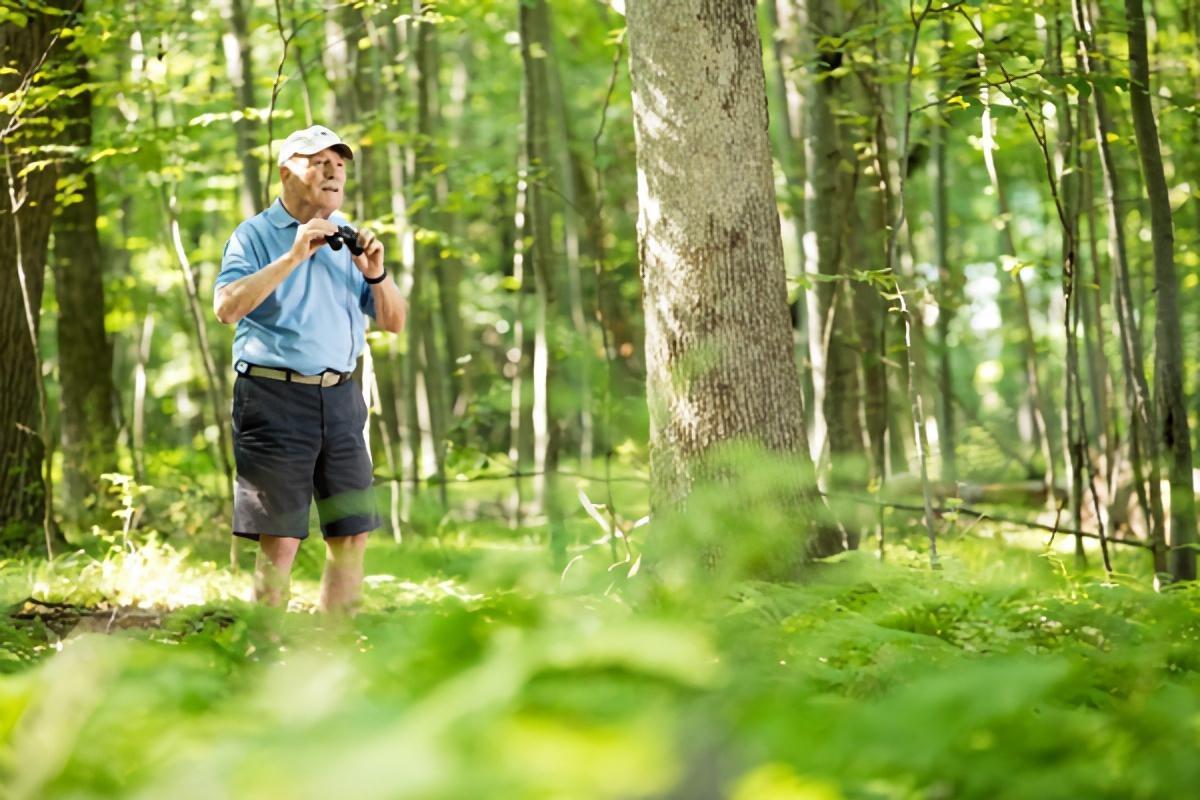
Hobbies keep the mind sharp and encourage an active, fulfilling lifestyle as we age. Why is birdwatching a great hobby for active seniors in Connecticut? It offers the chance to immerse yourself in one of the most beautiful landscapes, with lush foliage and rolling hills. Simply stepping outside to observe birds brings wellness benefits and deepens your connection to nature.
At Meadow Ridge, birdwatching is a beloved pastime that combines the joy of discovery with the peace of nature. Christine Schiffer, executive assistant to the executive director, shares her passion for birdwatching by sending out bird sightings, fun facts and photos she captures during her walks on our 136-acre campus and beyond, alongside the Insider newsletter.
If you live in Connecticut, especially in the Redding area, you’re in a prime location to enjoy this hobby. More than 50 bird species have been spotted on and around the Meadow Ridge campus, making it an ideal spot for both seasoned birders and newcomers.
Birds of Connecticut: A Beginner’s Guide to Birdwatching
As a beginner in the birdwatching world, look for some of these common Connecticut birds to get started on your checklist:
American Goldfinch
Source: Missouri Department of Conservation
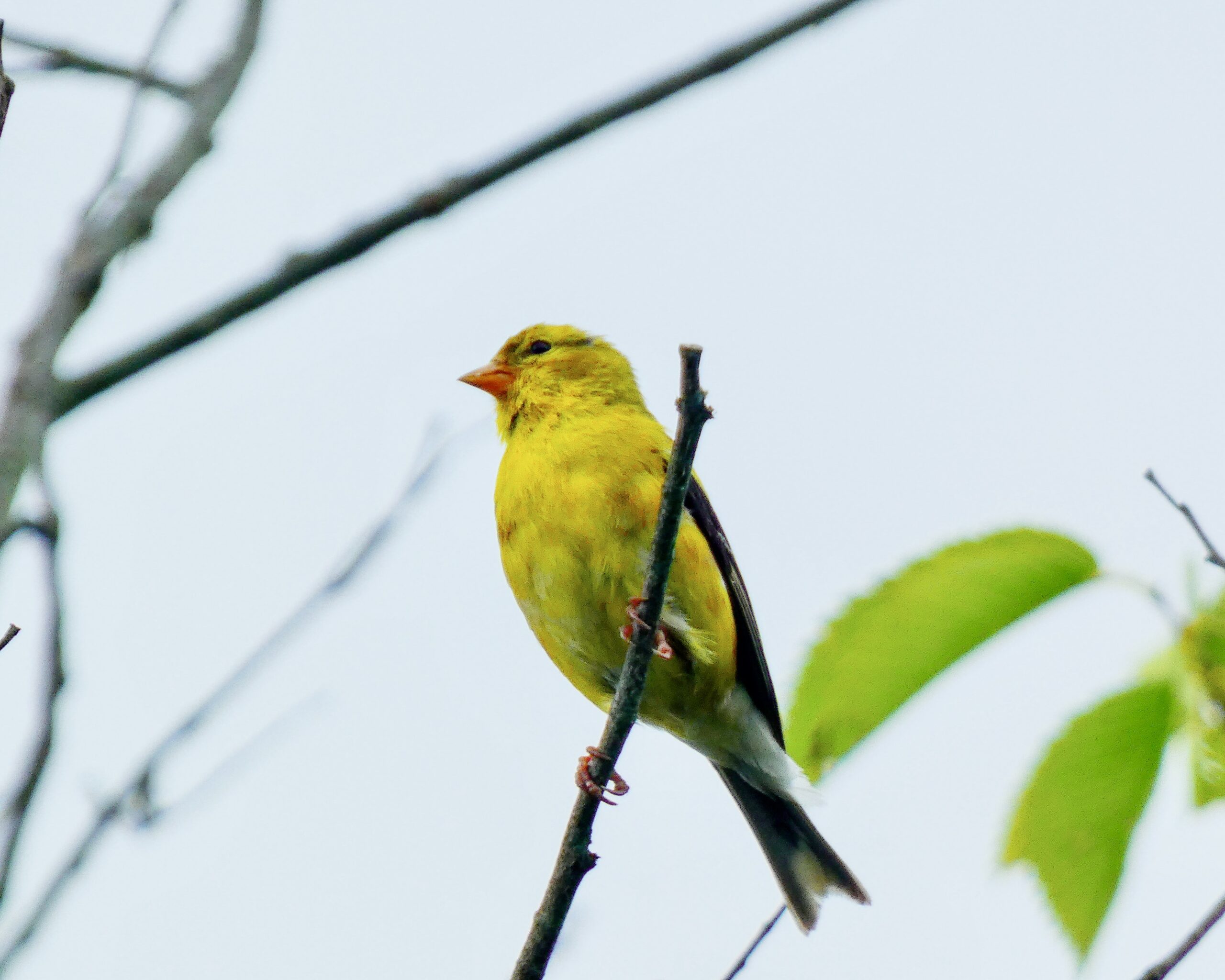
These small, sunny birds brighten up nature with their perky yellow plumage. The black head and tail feathers add contrast to the golden plumage in males. The female American goldfinch has distinctive dark brown
feathers that appear more olive in color than the male’s black. During the winter months, the goldfinch molts to reveal duller, drab colors, allowing the birds to blend in to the stark winter environment.
A curved conical beak rounds out the face of the American goldfinch. Light pink in color, the beak transforms to a fiery orange hue in both males and females during molting season. These birds eat seed almost exclusively. For feeding American goldfinches, leave out food mixes containing sunflower seeds or thistle sacks.
A twittering song containing a long note marks the call of the American goldfinch. The warbling music has a high-pitched tone with staccato notes and a chirping sound. The birds use two distinctive songs for defensive purposes during nesting. One of these songs is used to summon other goldfinches and protect the nest from a nearby predator. The second song alerts the mate and the nestlings to be quiet and crouch in the nest to be less noticeable.
The American goldfinch migrates for two specific reasons. They head south during winter months toward Mexico, where the climate is more agreeable. When breeding is imminent, the birds fly to the North Carolina area.
Baltimore Oriole
Source: National Park Service
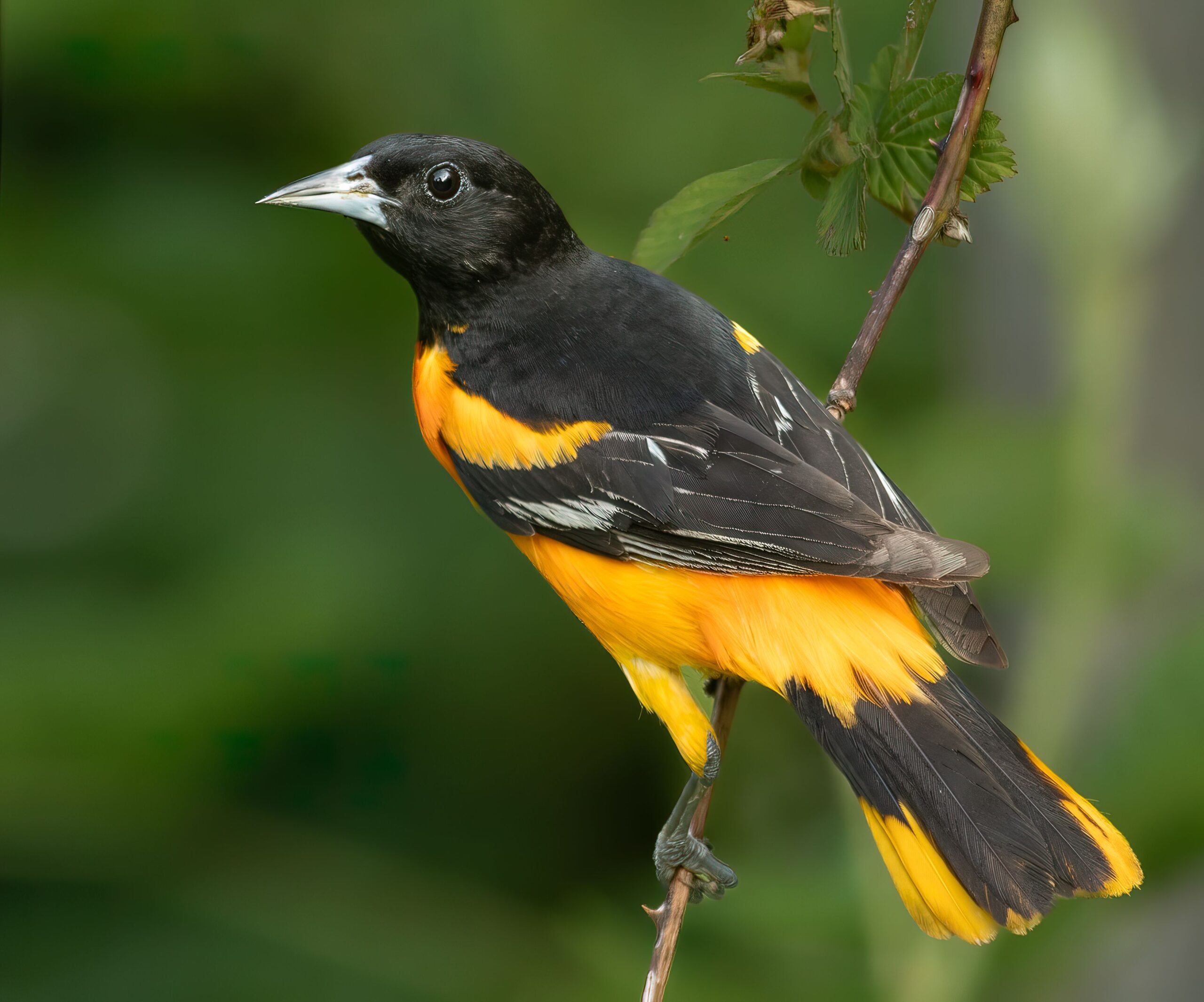
These famous birds stand out with their vibrant feathering and mascot status for the Maryland professional baseball team. The male bird is slightly larger than the female and boasts bright orange feathers with black accents. The female’s subtler coloring consists of yellow-brown feathers with gray and black contrast. Both the male and female adult Baltimore orioles have white bars on the wings.
The Baltimore oriole uses its thick, pointed beak to eat insects, seed, fruit and nectar. These birds will eat from a seed feeder or hummingbird feeders, but some people put up feeders specifically made for the oriole. These feeders look similar to hummingbird feeders but hold nectar of a more orange color and have larger perches, as the oriole is bigger than the hummingbird. Leftover fruits also attract the bird, making it more probable that the oriole will stick around to raise their young near your feeder.
The song of the Baltimore oriole is a loud, echoing chirp that sounds like a whistle. Their bold sound is familiar and reminiscent of early spring, as the birds enjoy perching in the tops of green, leafy trees.
These birds are found all over North America and Canada during summer months, but they migrate to Central and South America for the winter. Although they frequently migrate for breeding purposes as well, orioles may stay in the southern parts of North America for breeding if enough food is provided and the climate stays moderate.
Barn Swallow
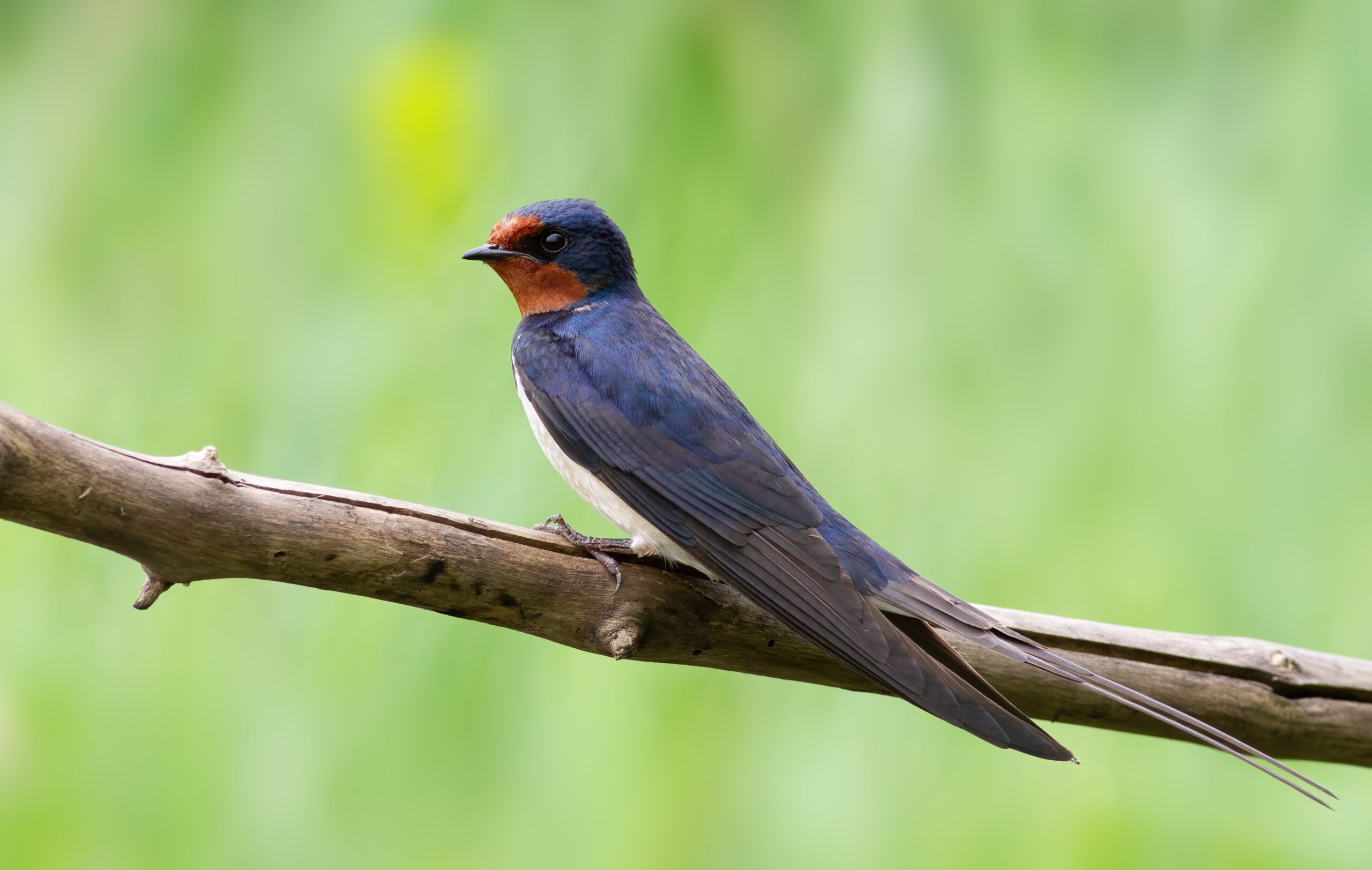
Source: U.S. Department of the Interior: Bureau of Land Management
Barn swallows have the distinction of being the most widespread swallow species in the world. Their blue wings have white spots toward the darker, more muted forked tail. The reddish-orange head and chest make the
barn swallow easy to distinguish from other birds.
Barn swallows eat insects exclusively and use diving maneuvers to snatch their prey from the ground or water surface. This diving strategy also helps with hydration, as the bird plunges to the water surface and scoops water with its open mouth. Large flies make up most of the barn swallow’s diet and the bird is known to follow around machinery, people and animals to prey on bugs that have been disturbed by their movements.
The song of the barn swallow consists of a cheerful trill and sounds like a su seer call punctuated with witt-witt noises. The bird has two alarm songs that differ depending on whether the predator is a barn cat or a more dangerous, larger bird that preys on barn swallows.
When breeding season approaches, barn swallows prefer finding man-made structures on which to build their nests. Their attraction to barns led to their obvious moniker. The barn swallow will breed in any part of the Northern Hemisphere, excluding desert zones and the coldest sections of the continents. During winter migration, the barn swallow doesn’t have a specific destination, avoiding only deserts and dense forests.
American Robin
Source: U.S. National Library of Medicine
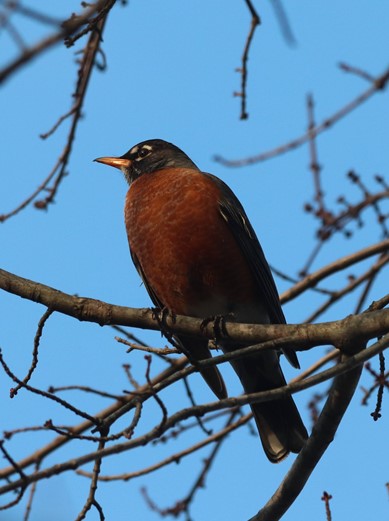
As the state bird of Connecticut, the American robin is arguably the most important bird on this list. The colors of the American robin vary with each bird, but typically, robins have a black/grayish head with white around the eyes, a red breast and a brown back and wings. The robin’s breast color varies with seasons and the bird’s gender, ranging from a peachy orange to a deep, rich red.
The bird’s yellow beak has a brown tip that darkens closer to black during the winter. The American robin’s diet consists of about 40% insects, worms and other invertebrates and 60% fruits and berries. This mixed nutrition allows the robin to stay further north during winter months, filling in any dietary needs with winter berries.
American robins generally sing a continual song, pausing only briefly in between long verses. Their song starts early in the morning and can be heard even after dark. When the robin is threatened, it sings a warning song to mates and offspring, sounding the alarm for nearby threats. The bird has also been known to start its melody right before a storm and after the storm ends. With a multitude of different tunes, the robin has a voice for every occasion.
The robin’s beautifully pale blue eggs can be found very early in spring, as the robin is the first to lay eggs each year. This early breeding can be attributed to their lack of migratory travel. In literature, the robin often symbolizes the beginning of spring and rebirth.
Black-Capped Chickadee
Source: Alaska Department of Fish and Game
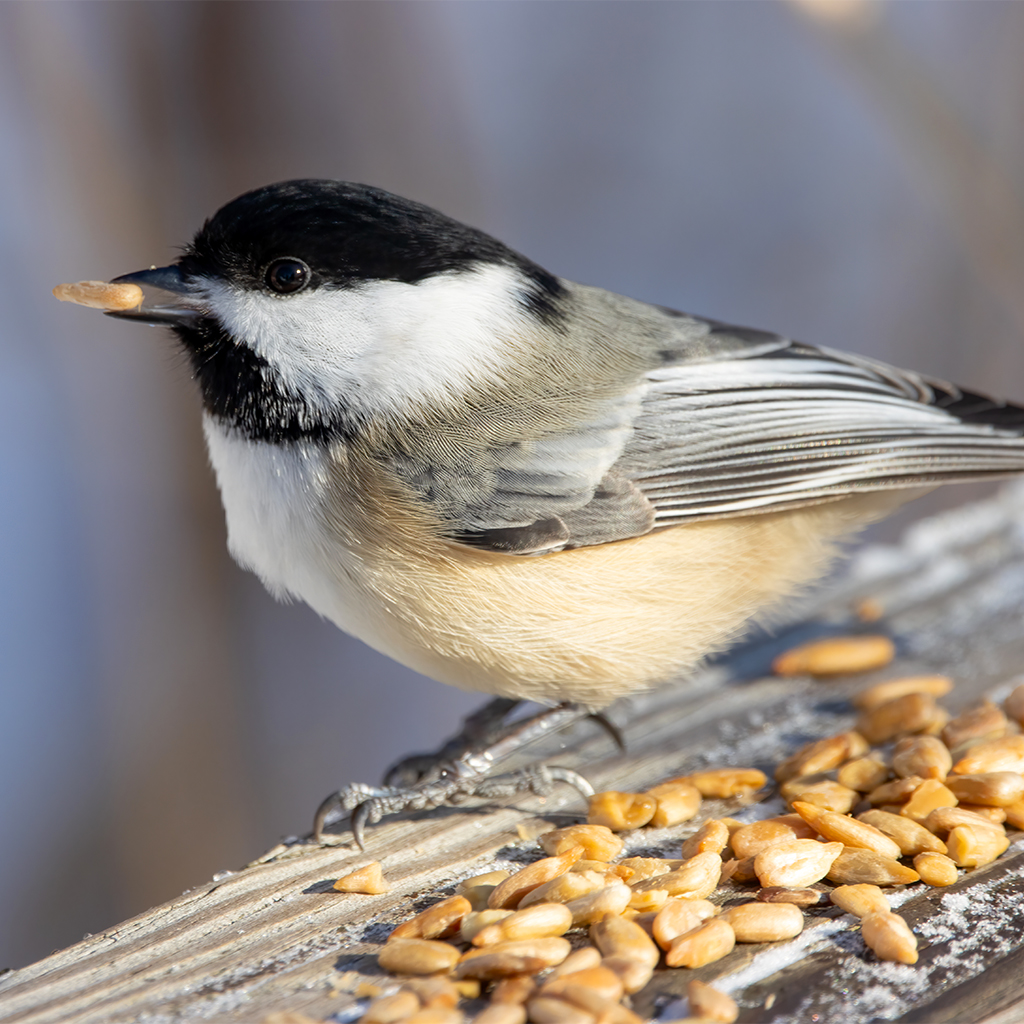
A bold, curious personality defines the black-capped chickadee. These birds go so far as to eat out of a person’s hand. True to its name, the black-capped chickadee has a black head and throat, with white cheeks and belly. The bird has light brown flanks and gray wings, leading to a dark gray tail.
To distinguish a black-capped chickadee from its close cousin, the Carolina chickadee, look for white edges on the tail feathers. These two birds overlap in geographic location, making it hard to tell them apart. Plus, the birds have learned to mimic each other’s calls, confusing bird watchers even more.
Caterpillars and other insects make up most of the black-capped chickadee’s diet. During the colder months when finding insects becomes harder, the birds rely on bug larvae, seeds and winter berries. To survive these harsh months, these resourceful birds store extra food in secret hideaways. They can recall these locations for up to 28 days after hiding the food.
The black-capped chickadee doesn’t need to migrate south during the cooler months, preferring to stay in one location year-round. They move together in flocks to hunt during winter months, discovering that foraging as a group brings the best results in their hunt for food.
While the typical song of the black-capped chickadee is a simple two-note whistle, birds have the ability to communicate complex messages to their mates and flock. Depending on how dangerous a nearby predator may be, the bird will add more ”dee”s to their song. For instance, a predator prowling the ground may get a sort of chicka-dee-dee-dee song, while a bigger threat like a pygmy owl will warrant a chicka-dee-dee-dee-dee-dee-dee-dee (up to 23 dees!). The male black-capped chickadees have distinct gargle tones they use to ward off other males, for either feeding or mating purposes. The complexity of the black-capped chickadee’s songs makes it an intriguing study for birdwatching enthusiasts.
Northern Cardinal
Source: Environmental Protection Agency
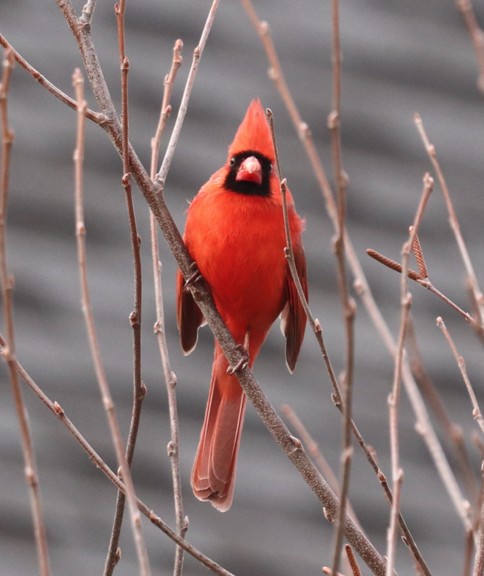
The northern cardinal’s bright red plumage makes it a favorite study for beginner bird watchers in Connecticut. Commonly known as a redbird, the male northern cardinal displays a more strikingly red coat and a black
mask; the female has a gray mask and her feathers lean toward a brownish-red color.
These beautiful birds feed mainly on seeds, but insects and fruit contribute to their diet. During the courtship period, the male gathers seeds and feeds them to the female, beak to beak. Their strong, cone-shaped beaks are commonly thought to be used for breaking open tough shells; in reality, the bird prefers seeds with softer, weaker shells. The females use their hard beaks to bend twigs and form the nests required for laying their eggs.
The song of the northern cardinal consists of whooping tweets, followed by quick staccato chirps. Their songs vary depending on the reason for the call and the birds typically repeat one phrase for a period and then alternate to another whistled song. They have a distinctive alarm song, comprised of short chip-chip-chip notes. As the predators get closer, the alarm becomes louder and more urgent.
It’s easy to get started.
If you’re just joining the millions of people who enjoy birdwatching, the National Audubon offers helpful resources for embracing this hobby such as making a list of common birds you wish to see and add a few rare birds to keep things interesting. Why not start with the birds listed in this article and then see if you can spot any of these Connecticut natives during your next outdoor hike?
Start paying attention to your surroundings when going on walks or picnics. Make it a point to get outdoors at least a few times a week to search for the birds on your list and get in the habit of carrying a pair of binoculars when you go outside.
Once you’ve checked off most of the Connecticut birds on your list, expand to nearby areas, or look up birds in places you plan to visit. Birdwatching keeps your focus sharp and gives you a good reason to spend time outdoors.
A Wealth of Activities for Every Interest
In addition to birdwatching, Meadow Ridge offers a variety of activities that cater to every aspect of wellness and well-being. From tai chi and pickleball to engaging group discussions, art classes and language courses, there’s something for everyone. Residents can enjoy our golf simulator, walking paths and entertainment options like live music, theater and trips to nearby museums. Whether seeking relaxation, social connection or personal growth, our community provides countless ways to stay active and engaged.